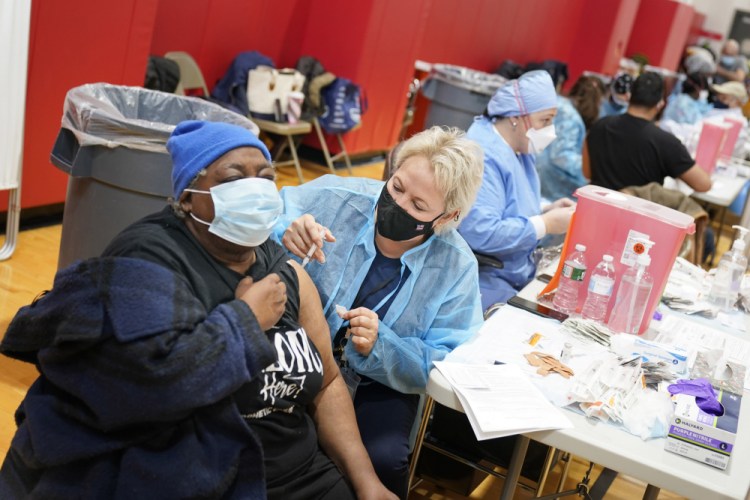Up to 100 sites run by the Federal Emergency Management Agency could begin offering coronavirus vaccine within the next month, part of a strategy that would dramatically expand the federal government’s role in the effort to corral the pandemic.
The plan, which was announced by President Biden on his first day in office, is already taking shape in the form of a draft “Concept of Operations,” which was obtained by The Washington Post. The document envisions FEMA, which previously had more of a piecemeal role in pandemic response, fully unleashed.
Its mission will be to “provide federal support to existing or new community vaccination centers and mobile clinics across the country.”
Enlisting FEMA, an agency of the Department of Homeland Security, is among the clearest signals that Biden intends to involve the federal government more directly in the administration of vaccines, instead of leaving the final step of the massive effort to state and local authorities.
“FEMA … will mobilize thousands of clinical and nonclinical staff and contractors who will work hand-in-glove with the National Guard and state and local teams to assist, augment, and expedite the distribution and administration of coronavirus vaccines,” the FEMA document states.
If requested by states and other jurisdictions, the draft notes, “the U.S. Government would develop, equip, provide information management, and staff and operate the site.”
Maine is now planning large-scale vaccination sites, and Gov. Janet Mills will review the Biden administration’s proposal as part of that process, said the governor’s press secretary, Lindsay Crete, in a statement Friday.
“The Governor is grateful to the President for his immediate offer to lend a hand and welcomes the new, robust Federal leadership,” Crete said. “We look forward to collaborating with the Biden Administration and expect to take advantage of every opportunity to expand COVID-19 vaccination in Maine.”
Shots administered at the FEMA sites are expected to draw on the vaccine supply made available to individual states and territories, and some large cities, rather than relying on a new federal allocation stream. A lack of abundant vaccine supply will remain the most pressing problem, probably through March.
The Trump administration, which oversaw the rapid progress in developing a half-dozen vaccine candidates, faced criticism in its closing days for not planning sufficiently for the ground-level hurdles to immunization, from workforce shortages to aging computer systems. Many states have already set up mass vaccination clinics, but officials say assistance will be needed to make sure the greatest number of people possible are vaccinated.
Others took issue with the Biden administration’s efforts, in a sign that greater federal coordination is already becoming politically charged. Florida Gov. Ron DeSantis, a Republican and close Trump ally, ridiculed the plan this week, referring to the anticipated centers as “FEMA camps.”
“I can tell you, that’s not necessary in Florida,” he said.
But the plan was welcomed by FEMA officials throughout the country, who spoke on the condition of anonymity because they had not been authorized to address the efforts.
One official said he was moved to tears by the new sense of purpose. “It’s amazing what we can do when we take the gloves off,” the official said. Another recounted a regional planning call in which emergency managers were discussing how to get additional information from states about the gaps in their existing infrastructure. Biden administration officials have begun calling state leaders to consult with them about how federal assistance could augment their capacity, according to people familiar with the calls.
The draft outlines four possible sizes for federally administered sites. The largest, called the “Mega Model,” would be able to administer 6,000 doses a day but require a space at least as large as 15,000 square feet. The smallest would extend across just 2,500 square feet and be able to handle 250 doses a day.
At the same time, the planning document sketches out hurdles to immediate involvement by FEMA personnel in some aspects of immunization, especially administration of shots, because of licensing requirements. Biden’s strategy encourages states to bolster their workforce, including by “expanding scope of practice laws and waiving licensing requirements as appropriate.” It also aims to allow state and local governments to receive greater reimbursement for vaccine administration expenses through the FEMA Disaster Relief Fund.
The draft FEMA initiative notes that federal managers will need to review local regulations “when determining clinic staffing and assignment of roles and responsibilities.”
“Depending on the situation, and authorization from the State Commissioner of Health, nonmedical personnel may be utilized for positions normally requiring a medical license/certificate,” the draft states.
FEMA had a leading role in the Trump administration’s early effort to locate and deliver medical equipment to the front line of the pandemic – an initiative known as Project Airbridge. That effort was phased out last summer, however, and the agency’s role in the pandemic response became highly uneven, especially as the Trump administration insisted on delegating responsibility to the states.
Biden’s COVID-19 supply coordinator, Tim Manning, is a former FEMA official. The president’s pick to lead the agency, Deanne Criswell, is New York City’s emergency management commissioner. She would be the first woman to lead the agency.
Send questions/comments to the editors.



Success. Please wait for the page to reload. If the page does not reload within 5 seconds, please refresh the page.
Enter your email and password to access comments.
Hi, to comment on stories you must . This profile is in addition to your subscription and website login.
Already have a commenting profile? .
Invalid username/password.
Please check your email to confirm and complete your registration.
Only subscribers are eligible to post comments. Please subscribe or login first for digital access. Here’s why.
Use the form below to reset your password. When you've submitted your account email, we will send an email with a reset code.